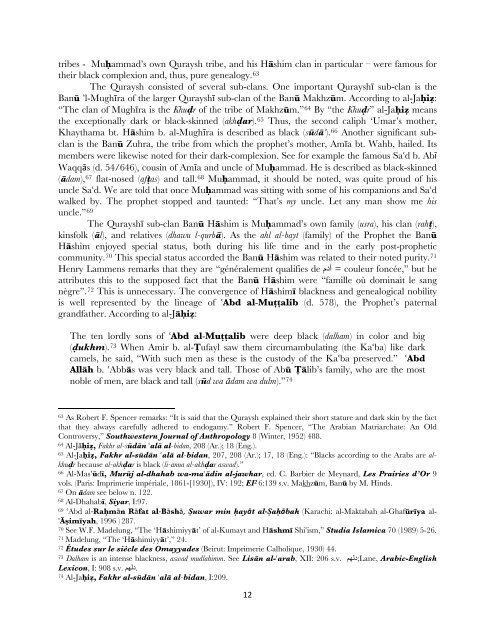“Anyone who says that the Prophet is black should be killed”: The ...
“Anyone who says that the Prophet is black should be killed”: The ...
“Anyone who says that the Prophet is black should be killed”: The ...
You also want an ePaper? Increase the reach of your titles
YUMPU automatically turns print PDFs into web optimized ePapers that Google loves.
tri<strong>be</strong>s - MuÈammad’s own Quraysh tri<strong>be</strong>, and h<strong>is</strong> H§shim clan in particular – were famous for<br />
<strong>the</strong>ir <strong>black</strong> complexion and, thus, pure genealogy. 63<br />
<strong>The</strong> Quraysh cons<strong>is</strong>ted of several sub-clans. One important Qurayshī sub-clan <strong>is</strong> <strong>the</strong><br />
Banå ’l-Mughīra of <strong>the</strong> larger Qurayshī sub-clan of <strong>the</strong> Banå Makhzåm. According to al-JaÈií:<br />
“<strong>The</strong> clan of Mughīra <strong>is</strong> <strong>the</strong> Khu∙r of <strong>the</strong> tri<strong>be</strong> of Makhzåm.” 64 By “<strong>the</strong> Khu∙r” al-JaÈií means<br />
<strong>the</strong> exceptionally dark or <strong>black</strong>-skinned (akh∙ar). 65 Thus, <strong>the</strong> second caliph ‘Umar’s mo<strong>the</strong>r,<br />
Khaythama bt. H§shim b. al-Mughīra <strong>is</strong> descri<strong>be</strong>d as <strong>black</strong> (såd§"). 66 Ano<strong>the</strong>r significant subclan<br />
<strong>is</strong> <strong>the</strong> Banå Zuhra, <strong>the</strong> tri<strong>be</strong> from which <strong>the</strong> prophet’s mo<strong>the</strong>r, Amīa bt. Wahb, hailed. Its<br />
mem<strong>be</strong>rs were likew<strong>is</strong>e noted for <strong>the</strong>ir dark-complexion. See for example <strong>the</strong> famous Sa#d b. Abī<br />
Waqqās (d. 54/646), cousin of Amīa and uncle of MuÈammad. He <strong>is</strong> descri<strong>be</strong>d as <strong>black</strong>-skinned<br />
(§dam), 67 flat-nosed (afãas) and tall. 68 MuÈammad, it <strong>should</strong> <strong>be</strong> noted, was quite proud of h<strong>is</strong><br />
uncle Sa#d. We are told <strong>that</strong> once MuÈammad was sitting with some of h<strong>is</strong> companions and Sa#d<br />
walked by. <strong>The</strong> prophet stopped and taunted: “That’s my uncle. Let any man show me h<strong>is</strong><br />
uncle.” 69<br />
<strong>The</strong> Qurayshī sub-clan Banå H§shim <strong>is</strong> MuÈammad’s own family (usra), h<strong>is</strong> clan (rahã),<br />
kinsfolk (§l), and relatives (dhawu l-qurb§). As <strong>the</strong> ahl al-bayt (family) of <strong>the</strong> <strong>Prophet</strong> <strong>the</strong> Banå<br />
H§shim enjoyed special status, both during h<strong>is</strong> life time and in <strong>the</strong> early post-prophetic<br />
community.70F70 Th<strong>is</strong> special status accorded <strong>the</strong> Banå H§shim was related to <strong>the</strong>ir noted purity.71F71<br />
Henry Lammens remarks <strong>that</strong> <strong>the</strong>y are “généralement qualifies de ﻢﺪﺁ = couleur foncée,” but he<br />
attributes th<strong>is</strong> to <strong>the</strong> supposed fact <strong>that</strong> <strong>the</strong> Banå H§shim were “famille où dominait le sang<br />
nègre”.72F72 Th<strong>is</strong> <strong>is</strong> unnecessary. <strong>The</strong> convergence of H§shimÊ <strong>black</strong>ness and genealogical nobility<br />
<strong>is</strong> well represented by <strong>the</strong> lineage of #Abd al-Muããalib (d. 578), <strong>the</strong> <strong>Prophet</strong>’s paternal<br />
grandfa<strong>the</strong>r. According to al-J§Èií:<br />
<strong>The</strong> ten lordly sons of #Abd al-Muããalib were deep <strong>black</strong> (dalham) in color and big<br />
(∙ukhm).73F73 When Amir b. al-•ufayl saw <strong>the</strong>m circumambulating (<strong>the</strong> Ka#ba) like dark<br />
camels, he said, “With such men as <strong>the</strong>se <strong>is</strong> <strong>the</strong> custody of <strong>the</strong> Ka#ba preserved.” #Abd<br />
All§h b. #Abb§s was very <strong>black</strong> and tall. Those of Abå •§lib’s family, <strong>who</strong> are <strong>the</strong> most<br />
noble of men, are <strong>black</strong> and tall (såd wa ādam wa dulm).”74F74<br />
63 As Ro<strong>be</strong>rt F. Spencer remarks: “It <strong>is</strong> said <strong>that</strong> <strong>the</strong> Quraysh explained <strong>the</strong>ir short stature and dark skin by <strong>the</strong> fact<br />
<strong>that</strong> <strong>the</strong>y always carefully adhered to endogamy.” Ro<strong>be</strong>rt F. Spencer, “<strong>The</strong> Arabian Matriarchate: An Old<br />
Controversy,” Southwestern Journal of Anthropology 8 (Winter, 1952) 488.<br />
64 Al-JāÈií, Fakhr al-såd§n #al§ al-bidan, 208 (Ar.); 18 (Eng.).<br />
65 Al-JaÈií, Fakhr al-såd§n #al§ al-bidan, 207, 208 (Ar.); 17, 18 (Eng.): “Blacks according to <strong>the</strong> Arabs are alkhu∙r<br />
<strong>be</strong>cause al-akh∙ar <strong>is</strong> <strong>black</strong> (li-anna al-akh∙ar aswad).”<br />
66 Al-Mas’ådÊ, Muråj al-dhahab wa-ma#§din al-jawhar, ed. C. Barbier de Meynard, Les Prairies d’Or 9<br />
vols. (Par<strong>is</strong>: Imprimerie impériale, 1861-[1930]), IV: 192; EI 2 6:139 s.v. Makhzåm, Banå by M. Hinds.<br />
67 On §dam see <strong>be</strong>low n. 122.<br />
68 Al-DhahabÊ, Siyar, I:97.<br />
69 #Abd al-RaÈmān Rāfat al-Bāshā, ‘uwar min Èayāt al-‘aÈābah (Karachi: al-Maktabah al-GhafårÊya al-<br />
#$ßimÊyah, 1996 ) 287.<br />
70 See W.F. Madelung, “<strong>The</strong> ‘H§shimiyy§t’ of al-Kumayt and H§shmÊ Shi#<strong>is</strong>m,” Studia Islamica 70 (1989) 5-26.<br />
71 Madelung, “<strong>The</strong> ‘H§shimiyy§t’,” 24.<br />
72 Études sur le siècle des Omayyades (Beirut: Imprimerie Calholique, 1930) 44.<br />
73 Dalham <strong>is</strong> an intense <strong>black</strong>ness, aswad mudlahimm. See L<strong>is</strong>§n al-#arab, XII: 206 s.v. ﻢﻬﻟﺩ;Lane, Arabic-Engl<strong>is</strong>h<br />
Lexicon, I: 908 s.v. ﻢﻬﻟﺩ.<br />
74 Al-JaÈií, Fakhr al-såd§n #al§ al-bidan, I:209.<br />
12
















